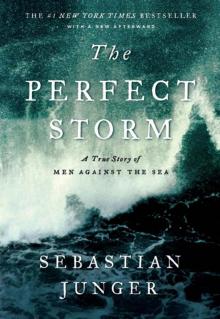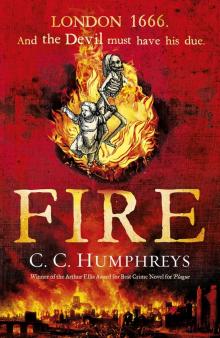- Home
- Sebastian Junger
Fire Page 2
Fire Read online
Page 2
“Smoke jumpers are considered an initial attack force,” Franz went on. “That’s a generic term for the first response to a fire. The classic situation would be a lightning-struck tree in a remote area where two guys jump in, fell it, buck it up—put out what amounts to a small campfire. Basically, the whole world’s a jump spot; within a mile of any fire you can usually find a very acceptable place to land in. On a big fire you have to start somewhere, so you jump a whole planeload and establish an anchor point, at the tail of the fire. You clear helispots for landing supplies, and you work your way around the sides of the fire.”
Smoke jumpers land with eighty pounds’ worth of gear, including two parachutes, puncture-proof Kevlar suits, freeze-dried food, fire shelters, and a few personal effects. Following them in cardboard boxes heaved out of the airplane with cargo chutes are chain saws, shovels, ax-hoe hybrids called Pulaskis, sleeping bags, plastic cubitainers of water, and dozens of other things needed on a fire. If there’s an injured jumper, a medical emergency pack comes out of the plane. If it’s a fast-moving fire, the crew can call for boxes of explosives that can blast an instant fire line in the forest duff. The list of what can be thrown at a fire is endless—and expensive. A more cynical view, popular among many, is that the government puts fires out by throwing money on them until it starts to rain.
Not much of the money, however, goes to the fire crews. A jumper makes about $8.50 an hour. If the fire is uncontrolled, as, since smoke jumpers are initial attack, it almost always is, the crews get another 25 percent hazard pay. If they work overtime—again, almost a sure bet—they get time and a half. The jump itself has been ruled as simply another way of getting to the fire, like a bus or a pickup truck, so jumpers get straight pay when they leave the airplane and time and a quarter when they hit the ground. If they are injured on the jump, however, and don’t make it to the fire, the hazard pay does not kick in. From fifteen hundred feet it takes about a minute and a half to reach the ground with a parachute. At $8.50 an hour, that’s about 21 cents.
“In a good year you can make almost thirty thousand dollars,” said Franz. (As with all fire fighters, a “good” year is a year with a lot of fires; a “good” fire is a fire that isn’t brought under control too quickly.) “Under twenty thousand is more typical. That’s for six months. The rest of the year we sew.”
They sew everything: harnesses, fire line packs, jump bags, even little duffels with the BIFC flame logo on the side. They do it to save the government money, they do it because they’re better sewers than most manufacturers, and they do it to keep themselves employed. The only thing they don’t sew are the parachutes. Some jumpers are certified to make repairs, but the chutes themselves are bought from a manufacturer. The parachutes the BLM uses cost a thousand dollars apiece and are expected, with upkeep, to last at least ten years. They were of a design invented by a French kite maker in the early 1900s. They are called Quantum Q5 Ram Air parachutes.
“Ram air means there are cells that fill with air,” said Franz. “They make the canopy so rigid you could walk across it. You could also put a line on it and fly it like a kite; in Alaska, jumpers fly their chutes like kites. You steer with toggles and have a forward speed of twenty miles an hour. It’s a very high tech delivery system for a very low tech job; once we hit the ground we’re just fire fighters. Afterward we have to pack ten miles or more, to the nearest helispot. Our gear weighs over one hundred pounds, and usually we’re not even on trails; it’s harder work than fighting fires. It keeps you honest.”
Honest means capable of enduring a training regimen that used to weed out 30 percent of the preselected men at the training camp (overwhelmingly men, but not entirely). Rookies are considered the fittest and most perfectly trained because they have endured boot camp most recently: three hours of workouts a day, a jump simulator called the Mutilator, an array of courses and tests that virtually guarantee you’ll pull your ripcord after jumping out of the plane. Overwhelmingly, it works, though not always. In 1991 a jumper in Montana was killed because he didn’t reach for his ripcord until “ground rush,” when it was too late. The entire thing was caught on video because it was a training jump. The consensus was he froze.
“The biggest hazard is probably the fire itself,” Franz told me. “Felling burning snags, logs rolling down hillsides. Jumping is usually a relief. It’s hot in the airplane, and sometimes you feel sick; then suddenly you’re totally focused on what you’re doing. It’s a little dreamlike.”
After our talk Franz took me for a quick tour of the jump loft. He showed me the rigging room where the chutes are packed, and the sewing room, and the weight room. Afterward we returned to the conference table, and he popped a short tape into the VCR. It was quick and unprofessional but highly dramatic. It showed a jump crew working a fire at night, right on the line. At one point a sawyer was cutting down a huge ponderosa, and his saw was halfway through the trunk when flames started pouring out like liquid. The tree was hollowed out by fire, it turned out, and was drawing like a chimney. The sawyer kept cutting; the flames kept spurting; eventually the tree fell.
As I left, I asked Franz—against all hope—if there were any fires around for me to see. He told me I’d just missed a good one. An older couple from Pennsylvania had been towing a car behind their RV, and the car got a flat tire; sparks started a fire front two miles wide. Six thousand acres, a million dollars to put out.
“I suspect the government will try to collect too,” he said. “Try the dispatch office; they’ll know what’s going on.”
The dispatch office for the Boise National Forest was a trailer east of the airfield. “I just came from BIFC,” I told the young woman behind the desk. “I’m a reporter. Are there any fires?”
I felt a little bad asking the question. She didn’t blink. “Seven hundred acres as of midnight last night,” she said, spreading a map of Idaho out on the table. “Lightning-started, wind-driven, with three helicopters and twenty-two crews. It’s called the Flicker Creek fire. They’ve called in a type one overhead team.”
A type one overhead team is called in only when a fire is really bad or is expected to get really bad. The Flicker Creek fire was in steep terrain with extremely dry fuels and strong winds. Steep slopes help a fire because uphill fuels get preheated; winds help a fire because they make it burn hotter and push it across the land. A seven-hundred-acre fire could jump to seven thousand or even seventy thousand in no time at all.
An hour later I was driving north on Highway 21 in my green fire-retardant Nomex pants and yellow fire shirt. In the back seat were a yellow plastic hard hat and a fiberglass and aluminum fire shelter. The shelter is a pup tent that comes in a small pouch with belt loops. It reflects radiant heat, reducing what would be a 1,000-degree fire to 120 degrees or so. I would be assigned a public relations person when I got to the fire camp, the ranger told me. I would be fed and I would be lodged in a tent if I didn’t have one. Tomorrow morning a helicopter would take me into the fire line.
I breezed past some bored Forest Service guards and turned off Highway 21, into the hills.
Flicker Creek is one of hundreds of small creeks that cut through the steep, dry hills of the Boise National Forest. Most of the land is grass and rocks and sagebrush, with heavy stands of ponderosa on the north slopes and in the drainages. Flicker Creek empties into the North Fork of the Boise River, which quickly joins the Middle Fork and continues on to fill the Arrowrock and Lucky Peak reservoirs. The entire West was seven years into one of the worst droughts since the 1870s, so both reservoirs were severely depleted. Arrowrock had been reduced to a muddy brook that you could practically jump across.
After twenty miles of rough driving, the road leveled off along the North Fork of the Boise. There was plenty of water up here—or so it looked—and the river was fast and lined with big, open stands of ponderosa. The fire camp was in a huge meadow called Barber Flats that ran alongside the North Fork of the Boise. Hundreds of bright nylon tents were pitched in
the yellowed grass. A helicopter thumped over a ridgeline, trailing a retardant bucket. Water trucks rumbled back and forth, spraying the dust down. Hotshot crews came and went, Indian file, or slept in the shade, or sharpened their tools. Some were black with dirt; others looked as if they’d just arrived. They all had on the same green and yellow Nomex that I wore and big lug-soled boots.
I parked my car between the trucks and water tankers and searched out the information desk. The public affairs people knew I was coming, and I was pointed toward a large, deep-voiced man named Frank Carroll. “You’ll need boots if you want to go out on the line,” he told me. “You’ll need water bottles; you’ll need food; you’ll need gloves. I’ll set you up after dinner. You can pitch your tent anywhere you like. People get going around five in the morning; make sure you’re at breakfast and ready to go by then.”
I thanked him and went off to get my gear set up. All around me, big, lean men and a few women went about their duties. I pitched my tent in tall grass behind a cabin that served as a command post and then wandered over toward the catering tent. Behind it was a full-size truck outfitted as a kitchen. Hotshot crews passed by it in line, taking plates of food from the young woman behind the window and then sitting down at folding tables under a canvas army tent. The woman was pretty and had a sheath knife on her belt. I tried to pretend I belonged there, and she loaded my plate up with steak and carrots and mashed potatoes and salad and two slices of white bread.
I took a seat by myself at a corner table and watched the crews come and go, talking loudly, eating fast. Most of the fire fighters were young white men, sinewy and unshaved. There was a scattering of women among them, but the women were treated—as far as I could tell—no differently from anyone else. I didn’t think they would be discriminated against so much as subjected to one form of gallantry or another, but they weren’t. Everyone seemed to be too tired and hungry to notice the opposite sex. (This turned out to be emphatically untrue.) Furthermore, beneath the baggy clothes and grimy faces it was hard to tell who was what.
The Indians and Latinos generally had their own crews. It was a reflection of demographics more than anything else: Twenty men from Browning, Montana, are likely to be Blackfeet, not white; twenty men taken off the farm crews in the Snake River valley are likely to be Latino, not Indian. It’s the Indian crews, the caterer told me, that can really clean out a food truck. “They’ll eat anything that’s not nailed down,” she said. The convicts eat sweets and spicy foods because they can’t get much of that in prison. The white ’shot crews are the most health-conscious: They eat a lot of fruits and vegetables; some won’t even touch meat.
That was hard to imagine, because the government food contracts were defined by how much protein—meat, in other words—was provided per person per meal. Everyone gets four ounces of meat at breakfast, seven ounces at lunch, and ten to sixteen ounces at dinner. Everything else—vegetables, grains, fruit—was considered a condiment and didn’t figure into the equation. It’s a lot better than it used to be, though. Back in the dark ages of fire fighting—before women, before showers, before Nomex—the crews subsisted mostly on ham.
Ham and eggs, ham sandwiches, fried ham. Catering trucks were essentially big meat lockers with ham hanging in them, and maybe some Wonder bread. Back in those days the hotshots wore T-shirts that said, “When forests burn, pigs die.”
After dinner I sat in on the planning session. It was held under a ponderosa pine by the dirt parking area. The entire overhead team was there, identifiable by the fact that they weren’t dirty and weren’t wearing Nomex. They were trained together and used on the Flicker Creek fire as interchangeable parts of a network called the Incident Command System. The system is based on the idea that any person trained for a certain job—logistics chief, information officer, helibase manager—can perform that job for any agency, in any situation. Overhead teams are made up of people from a dozen different government agencies and are pulled in from all over the country. You might find an incident commander from Georgia and an air operations branch director from Colorado and a safety officer from the next town over. There are seventeen type one overhead teams in the country, and they mainly fight fires, but they have also been effective on other catastrophes: oil spills in Alaska; hurricanes in Florida; earthquakes in Mexico. An overhead team was sent to clean up the Valdez oil spill, for example, and the system worked so smoothly that it was copied by both the Exxon Corporation and the U.S. military. A fire camp with an overhead team, in fact, can put two people in the field for every one person acting as support—a ratio roughly twenty times as efficient as the military’s.
I went to bed when the five hundred fire fighters did, at dark. The only noise was the continuous rumble of the generators. The planning session had brought bad news, in a way: The fire was cooperating almost too quickly. A thirty-acre spot fire had started in light fuels on the south front but had been contained by three crews. Seven type two crews—less experienced than hotshots and usually used for mopping up—had cut line all the way down to the river, farther than expected. The winds were dying down, and unless they picked up again, the fire would be contained within days.
A fire camp is never completely still. All night long I was aware of the movement of men. They walked past, packed equipment, coughed, spat. Around four in the morning the sounds were so continuous that I woke up even before my watch alarm went off. It was still dark, and the camp undulated with human forms and occasional headlamps. Crews were packing their line gear, drifting toward the catering tent, clustering around the big stand-up kerosene heaters set up at intervals in the field. It was cold, maybe in the twenties. I crawled out of my sleeping bag and pulled on several sweaters and my boots—I had to wear leather on my feet in the helicopter, for some reason—and hustled toward the lights of the tent.
The person assigned to me was Bill Casey, a type two safety officer from the Boise area. He was a strong, clear-eyed man in his late forties who directed the local Bureau of Land Management district and was also qualified to command a type two overhead team. (A type two team handles smaller fires, but operates the same way.) He had bagged thirty elk in the past thirty-two years of hunting them, he said. His father hunts with him and can still shoulder fifty pounds of elk meat, at age seventy-one. Casey is part Blackfeet; he has dead-straight gray hair and brown eyes and a handsome, open face.
“We’re a little overstaffed because the fire didn’t do what we expected,” he admitted as we sat in his truck at the helibase.
“What did you expect the fire to do?” I asked.
“Well.” He chose his words carefully. “The guys don’t want to see the forests burn, but on the other hand, they want to have a good, productive summer. They like to have two to three weeks on a fire and then move on to another one. In that sense, it’s disappointing to have the fire lay down so fast.”
We were waiting for our flight into the fire line, and the heater was going full blast in the truck. In the clearing, men were checking the helicopters and writing up flight manifests. The first few days of a fire are usually disorganized to the point of chaos, Casey said. Then it gets better. Casey took advantage of the wait to tell me more about how fires are fought—not from the field but from the office.
“BIFC is just a logistical center that responds to needs in the field,” he said. “Suppose Unit X has a fire. As long as it doesn’t escape the initial attack, BIFC is not involved. If it does escape, then a regional coordination center gets involved. If the regional center doesn’t have enough resources to fight the fire, then BIFC steps in. We’ve had a lot of fires already this summer, and this is the first one where BIFC has been involved.”
Initial attack, he said, comes in many forms. Smoke jumpers are initial attack. Helirappelers are initial attack. Hotshots can be both initial attack and extended attack. Air attack—retardant drops from planes and helicopters—can also be initial or extended. The idea of initial attack is to hit the fire hard and early so that you avoid th
e expense of an extended campaign. If the attack crews can’t contain it, then an overhead team is assembled and put on the fire. A really big fire will suck in ’shot crews from all over the country. There are a total of sixty nationwide. If that’s not enough, or if they’re needed elsewhere, then type two crews that are trained in fire but often do other work for the Forest Service and BLM are deployed. Farther down in the barrel are convict crews, laborers from the Snake River valley who collect at the center of town when sirens go off, and pickup crews. Pickup crews usually just consist of people with sturdy shoes and in good enough health to pass the training course. When there are pickup crews on a fire, it’s a really bad fire. There were no pickup crews on the Flicker Creek fire.

 War
War The Perfect Storm: A True Story of Men Against the Sea
The Perfect Storm: A True Story of Men Against the Sea A Death in Belmont
A Death in Belmont Fire
Fire The Perfect Storm
The Perfect Storm A World Made of Blood (Kindle Single)
A World Made of Blood (Kindle Single)